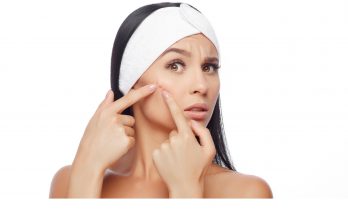Ah, the curse of hormones on the skin. When we were teens, all we wanted was to dry up the extra oil that brought on acne during those awkward years. Once we hit our 40s, our hormones make a comeback, but this time they dry out the skin just as our first signs of aging begin to appear in the form of fine lines and sun spots.
As estrogen levels fall, oil glands begin to shrink, causing skin to dry as it thins. Meanwhile, our ability to produce collagen, which rejuvenates and keeps our skin plump, starts to decline around the age of 25—even more so if you spend too much time soaking up rays. This horrible one-two punch results in dull, sagging skin and more pronounced wrinkles.
Thankfully, there are many ways to give skin a glow ranging from over-the-counter products to non-invasive treatments at your dermatologist.
Moisturize, Moisturize, Moisturize
Creams touting the ability to erase fine lines are a dime a dozen. But with the right ingredients, moisturizing creams can help skin appear plumper and less wrinkled. Dermatologists recommend these products:
- Hyaluronic acid to hydrate the skin
- Ceramides, repair damaged skin
- Niacinamide can lighten sun spots and pigmentation
- Glycolic acid, which helps speed up cell turnover for smoother skin
One of the most recommended store-bought creams harkens back to our grandmothers: Olay’s Regenerist Micro-Sculpting Cream (around $22 for 1.7 ounces).
Get Your Vitamins
When it comes to reducing fine lines and wrinkles, clearing acne, boosting collagen growth and even fading pigmentation, vitamin A is the key. Retin-A has long been proven to be the best anti-aging agent, with medical research repeatedly supporting its use, including a 2006 study published on the National Institutes of Health. Over-the-counter retinoids, such as Roc Retinal Correxion Deep Wrinkle Night Cream (around $20), are available in the form of retinol, which is a weaker—and cheaper—version of Retin-A. However, more potent Retin-A is only available by prescription (about $100). This topical only needs a small daily to thrice weekly application and provides long-lasting results after a few weeks’ use.
Enjoy Facials
Skin treatments at a spa or your dermatologist’s office can help rejuvenate skin. Facial massages stimulate collagen, as does derma-rolling, a process using fine needles to prick the skin and force the body to repair the wound. Also known as micro-needling, a derma-roller leaves users with smoother, fuller skin. At-home kits are available, including a Rodan + Fields system sold for $220.
You can also improve the appearance of your skin using a chemical peel. These often use glycolic acid to reduce fine lines. Over-the counter peels are mild, such as Perfect Image Glycolic Acid 30% Peel ($40), and work best when you are just starting to notice fine lines. For deeper lines and skin rejuvenation, your dermatologist can apply stronger acid-based peels (from $150 to $400) that will also create wounds to force your skin to create new skin faster.
Turn up the Heat
If you’ve tried everything and your skin is still lackluster, dermatologists recommend laser treatments. Laser resurfacing uses short, pulsating light beams to remove layers of skin, with results visible after one treatment—although most doctors recommend six treatments spaced out every four to six weeks. At-home kits perform similar skin tightening and lightening at a lower strength. More treatments are needed to see results with these, but devices such as Tria Age-Defying Laser’s near $500 price tag is far less than the in-office treatments that could cost $1,000 per session.



